What is CropManage?
CropManage is a free web-based irrigation and nitrogen management software created by the UC Cooperative Extension. The software uses multi-year local research data to estimate plant growth and therefore assess nitrogen uptake and water use.
In Ventura County, CropManage is currently adapted to create recommendations for strawberries (Fall- and Summer-planted) and celery. We are currently conducting studies to include different commodities such as cilantro and cabbage.
CropManage is a comprehensive software with many customizable features. We have created two sets of instructions on how to use CropManage: a quick guide that will give you a general idea of the steps necessary to use the software, and a detailed guide. The recording of a hands-on webinar conducted in May 4 2021 is also available below.
Quick Guide
- Create a CropManage account
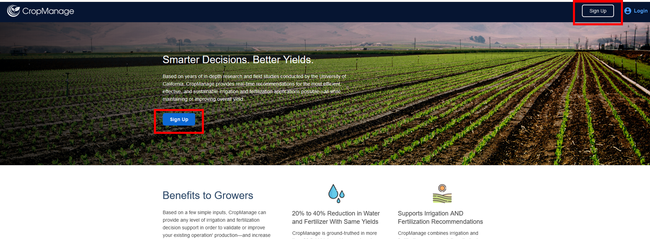
- Create a Ranch
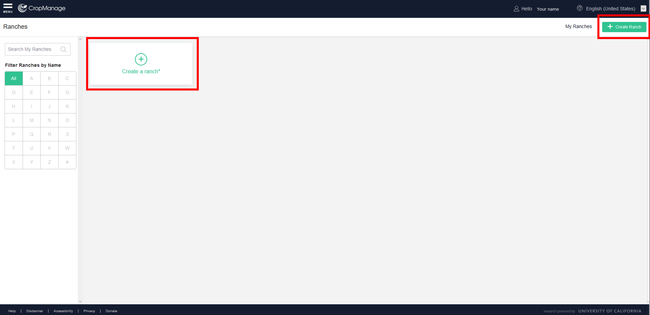
- Add Ranch Members, Planting Areas, Fertilizers, Weather Stations, Water Sources, and Commodities.
Definition: A Planting Area refers to a field, block, lot or orchard on your ranch. 

- Add a planting and fill out the required fields according to your field characteristics, including Irrigation, Soil, and Crop Settings.
Definition: A Planting refers to a crop or orchard. 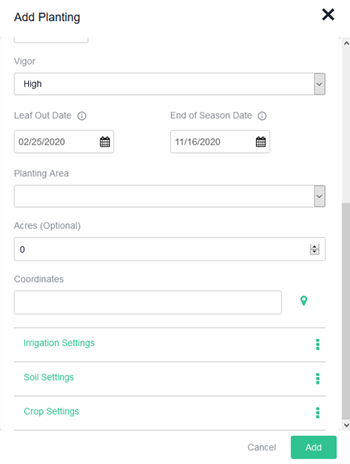
- Create an irrigation and/or a fertilizer recommendation by clicking the “Add Event” icon
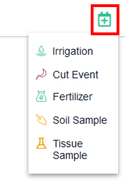
CropManage Webinar
Recently, advisors Michael Cahn and Andre Biscaro hosted a webinar providing a detailed walk through of the CropManage software. Watch this to learn more about how CropManage works and to see the software being used hands on. Feel free to make a CropManage account and follow along!
Detailed Guide Contents
Here, we provide an overview of CropManage and how to use the website. For a more technical guide, see the CropManage Documentation at http://help.cropmanage.ucanr.edu/tutorials/ or watch the webinar provided above.
Create an account
- Go to https://cropmanage.ucanr.edu
- Click on “Sign Up” in the top right corner or the middle of the page

- Enter your details on the next screen and click “Create Account”
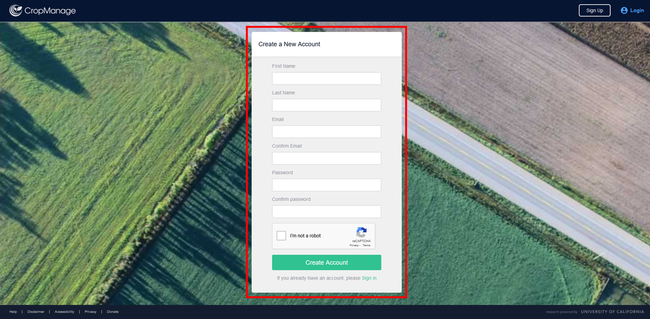
- You should receive a confirmation email to the email address that you provided. If it is not in your inbox, make sure to also check your Junk or Spam folder. Follow the link in this email to confirm your account.
- Then sign into your account using the email and password you provided.
Now you are ready to get started!
Getting started
- When you first open CropManage, you will see a screen with an option to “Create a Ranch”.
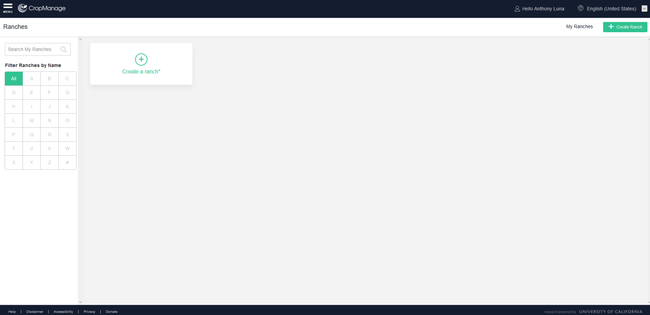
- This page is where you can access your ranches. For more details on creating a ranch see Setting up a ranch.
- To access your account settings, you can click on the menu icon in the top left corner.
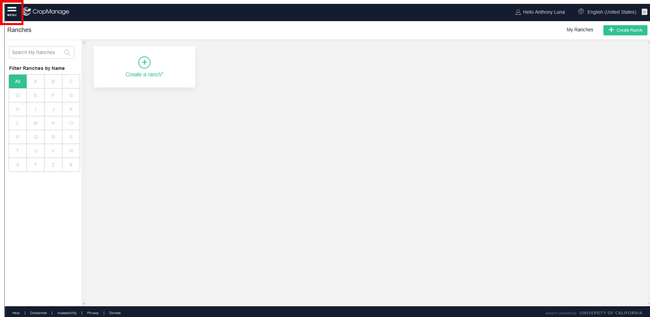
- This will allow you to access your profile details, the help documents, your ranches, a log out button, a form to submit feedback on CropManage, and a place where you can donate to this project. You can click the X button to close this menu.
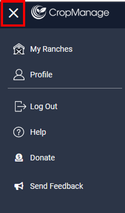
Now you are ready to set up your first ranch!
Setting up a ranch
- Once you have logged into your CropManage Account, click on the “Create Ranch” button in the top right corner or in the middle pane

- This will open a window that asks for the name of your ranch, the acreage of the ranch, and the coordinates of the ranch. Please enter these details before continuing.
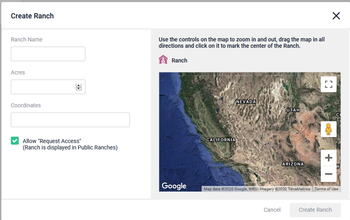
- You can use the map on the right to select the coordinates of your ranch by zooming into to the location of your ranch and clicking on the map where you would like to place the coordinates. You should see a pick home icon and the coordinates update in the input area.
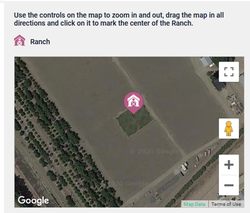
- If you would like this ranch to be private, uncheck the “Allow ‘Request Access’” tick box.

- At this point, you may see a blank screen with the text “Missing Ranch Settings”
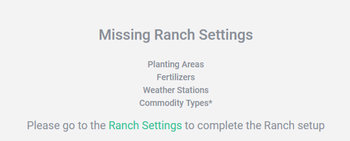
In order to access these settings, click on the gear icon in the top left corner next to the ranch name.
- Ranch Members: If you would like to add others to you ranch, you can use this to invite other CropManage users. Here you can control the access that each user has as well. For more detailed instructions on adding and managing ranch members, see http://help.cropmanage.ucanr.edu/2018/02/14/adding-managing-communicating-with-ranch-members/
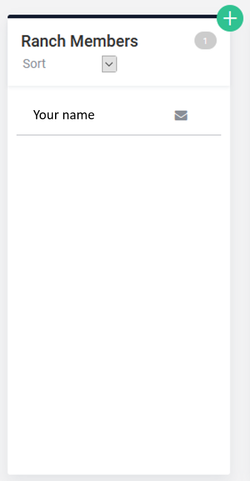
- Planting Areas: Here you can define the different planting areas on your ranch and designate the soil texture information. CropManage provides both UC Davis Soil Web Data and more recent certified data when available: for Ventura County fields, please use "UC Davis Soil Web Data". You can also edit the texture information based on your soil samples by clicking in the three vertical dots right besides 'Soil Type'. For more detailed instructions and adding and managing planting areas, see http://help.cropmanage.ucanr.edu/2020/02/25/adding-and-managing-lots/
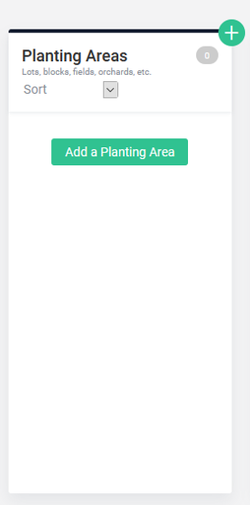
- Fertilizers: Here you can add the different types of fertilizer that you use through the growing season. If you choose a fertilizer from the list, make sure that its information (density and % N) are correct - those are fertilizers added by other users and there is not a quality control for the values entered. For more detailed instructions on adding and managing fertilizers, see http://help.cropmanage.ucanr.edu/2018/02/14/adding-and-managing-fertilizers/
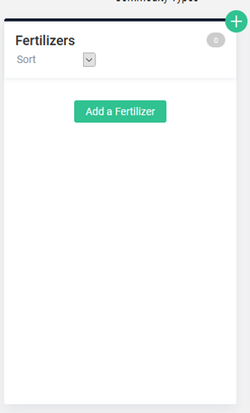
- Weather Stations: Here you can add weather station data provided by the California Irrigation Management Information System (CIMIS). For more details on CIMIS see https://cimis.water.ca.gov/ . For more detailed instructions on adding and managing weather stations, see http://help.cropmanage.ucanr.edu/2018/02/14/adding-and-managing-weather-stations/
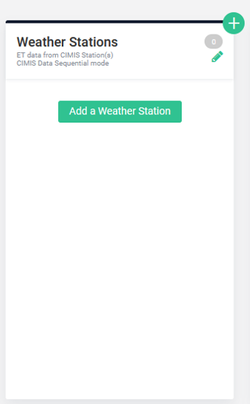
- Water Sources: Here you can add the different water sources available at your ranch. You can also add the nitrogen content in the water so it can be accounted for the nitrogen fertilizer recommendations. For more detailed instructions see http://help.cropmanage.ucanr.edu/2018/02/14/adding-and-managing-wells/
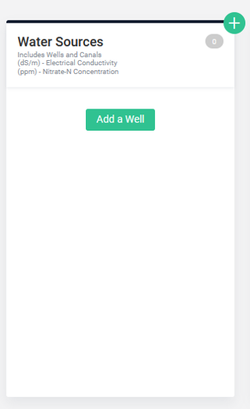
- Commodities: Here is where you can add your commodities that will be cultivated at your ranch. In Ventura County, CropManage is currently adapted to create recommendations for strawberries (Fall- and Summer-planted) and celery. We are currently conducting studies to include different commodities.
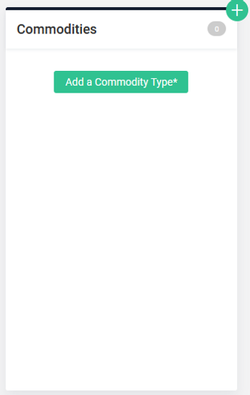
Now you are now ready to set up a planting!
Setting up a planting
Now that you have a Ranch set up, you can now add a planting.
- Click on the ranch that you created to add a planting to that ranch
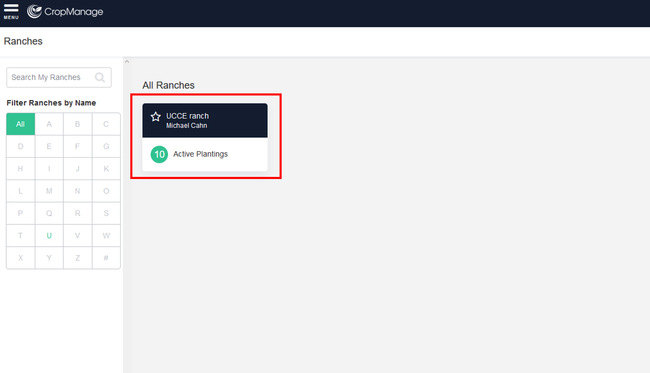
- Click on “Add Planting” in the top right corner
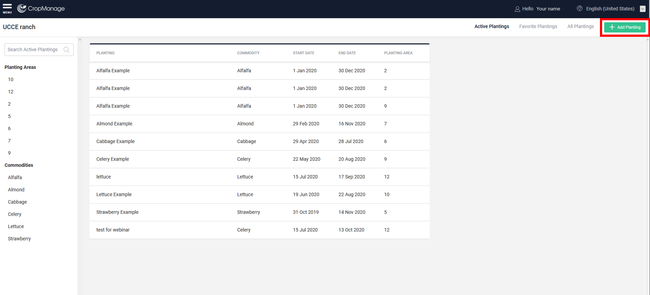
- Now you can add details related to the planting including
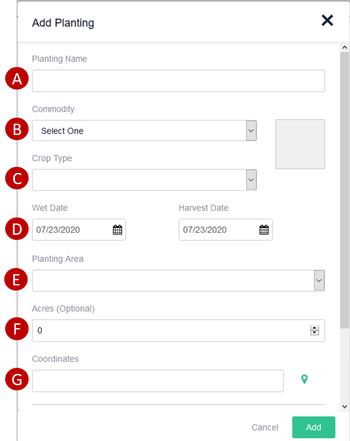
- Planting name – This is a name used so you can identify each planting. If you have numerous plantings, consider using a determined naming convention to keep your plantings organized.
- Commodity – This is where you select the commodity type of the planting. This list contains all the commodities that are supported in the integrated recommendation system provided by CropManage
- Crop Type – This is where you can select planting density and different cultivar where available.
- Wet Date and End of Crop Date – This is where you set the planting date and the estimated planting termination date.
- Planting Area – This is where you define the planting area of the planting. These areas were defined in Setting up a Ranch in step 7.
- Acres (Optional) – Acreage of planting. This is optional.
- Coordinates – This is where you define the center of the planting. You can select a place on the map as shown in Setting up a Ranch in step 3.
- Depending on commodity type and crop type, these settings may vary. For more detailed instructions on adding a planting see http://help.cropmanage.ucanr.edu/2020/03/13/adding-a-new-planting/
After you have entered these descriptions, you can provide additional configurations for Irrigation, soil, and crop settings. As with the general settings, the options available will change based on the commodity type and crop type chosen.
- To edit irrigation settings, click on “Irrigation Settings” At the bottom of the settings page - you may have to scroll down to see this.
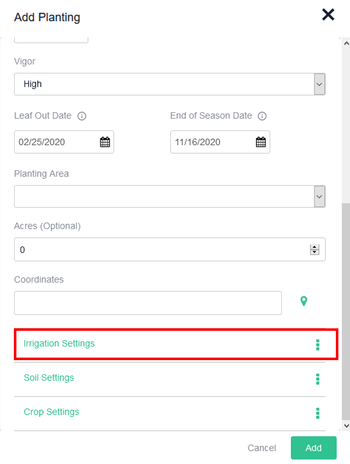
- Once you have opened the irrigation settings, you can see more detail for each input by hovering over the tool tip icon with your cursor.

- To edit soil settings, click on “Soil Settings” At the bottom of the settings page - you may have to scroll down to see this.
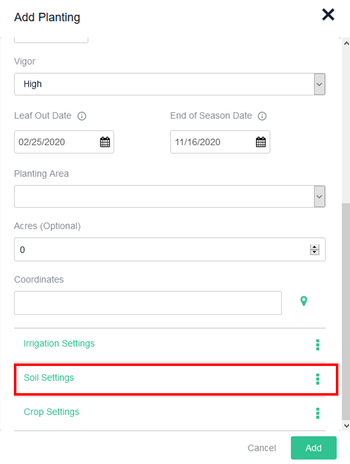
- To edit crop settings, click on “Crop Settings” At the bottom of the settings page - you may have to scroll down to see this.
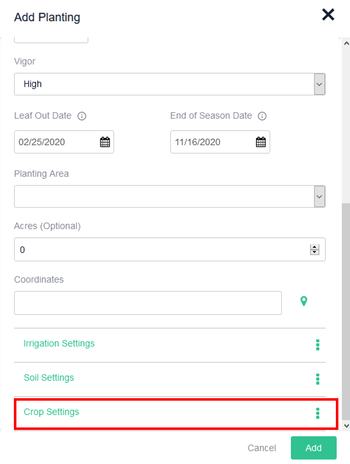
Adding events
Events are used for two purposes, both to record information from sampling events such as tissue and soil sampling and to record management processes including irrigation and fertilization. Irrigation and fertilization events provide a means for recommendation based off of all the information provided to CropManage, and the sampling events add to the available information in CropManage to improve the recommendations produced by the platform. To get started with adding event:
- Click on a planting on your ranch which will bring up a pane on the right side of the screen. This is your planting event tracker where you can see past (A) and upcoming (B) events as well as add new events (C). Here you can also edit settings of the planting (D), recalculate recommendations (E), duplicate the planting (F), and view charts related to the planting (G).
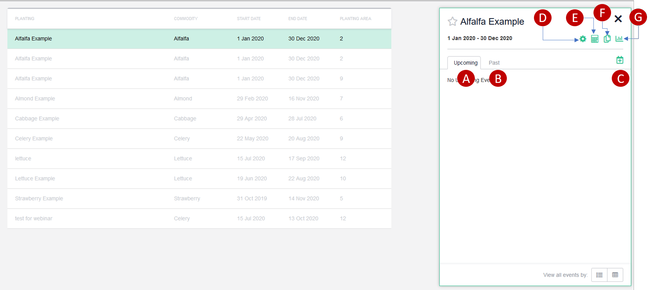
- To add an event, click on the add event icon (C). Here you can choose between an irrigation event, a fertilizer event, a cutting event, a soil sampling event, and a tissue sampling event.

In this guide we will cover irrigation, fertilizer, soil sample, and tissue sample events. For more detailed instructions see http://help.cropmanage.ucanr.edu/category/tutorials/creating-events/
Irrigation Event
- To add an irrigation event, click on “Irrigation”.
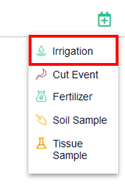
- This will bring up a window with both the date of irrigation, and the method of irrigation. Select this as it applies to your planting area.
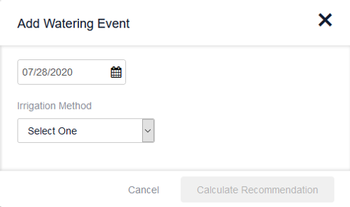
- Once you have clicked “Calculate Recommendation” button, CropManage will provide a recommendation for the hours or inches to irrigate.
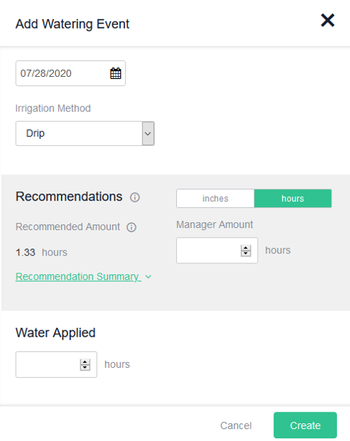
- After the manager has irrigated, they should then enter to actual number of irrigation hours under “Water Applied”
- Finally, click the “Create” button to save the event.
- For more detailed instructions see http://help.cropmanage.ucanr.edu/2020/03/20/adding-an-irrigation-event-by-gerry/
Fertilizer Event
- To add a fertilizer event, click on “Fertilizer”.
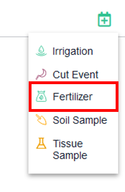
- This will bring up a window with the date of fertilization, the fertilizer type, number of planned fertilizations per month, and the Crop Stage (which is optional). Select these settings as it applies to your planting area.
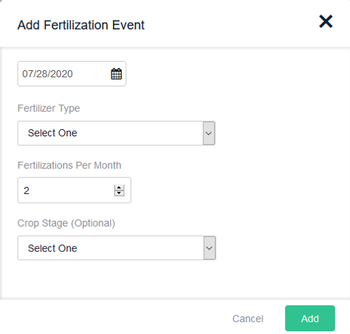
- Once you click “Add” at the bottom, CropManage will provide a recommendation based on your planting, planting area, and general ranch settings. There is also an option to include a soil sample reading that provides current nitrate in the soil that will modify the recommendation. There is also the option to include nitrogen from water source as defined in your ranch settings.
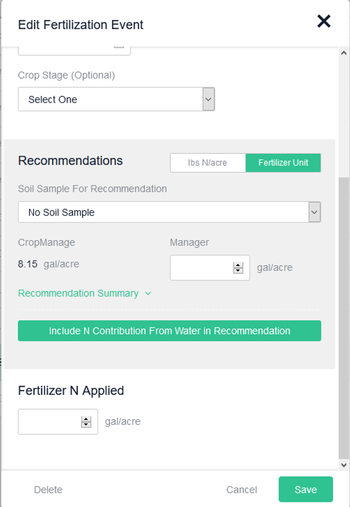
- After the manager has fertilized, they should then enter to actual amount fertilized under “Fertilizer N Applied”
- Finally, click the “Save” button to save the event.
- For more detailed instructions see http://help.cropmanage.ucanr.edu/2020/04/24/adding-fertilizer-events-for-vegetable-commodities/
Soil Sample Event
- To add a fertilizer event, click on “Soil Sample”.
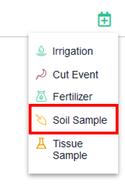
- This will bring up a window with the date of soil sample, the sample depth, the sample type, and the Crop Stage (which is optional). Select these settings as it applies to your soil sample.
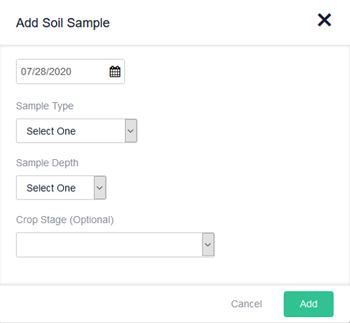
- Once you have set your options for the soil sample, CropManage will provide more fields where you can enter the results from the soil sample test.
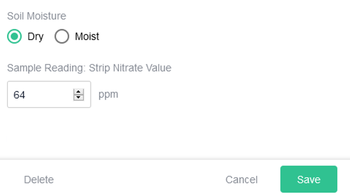
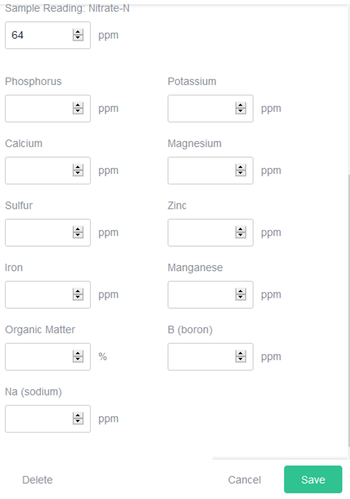
- After the manager has fertilized, they should then enter to actual amount fertilized under “Fertilizer N Applied”
- Finally, click the “Add” button to save the event.
- For more detailed instructions see http://help.cropmanage.ucanr.edu/2020/04/23/adding-soil-sample-events-for-a-planting/
Tissue Sample
Tissue samples are used for record keeping purposes. At this time they are not used in the calculations involved in creating a fertilizer recommendation.
- To add a tissue sample event, click on “Fertilizer”.
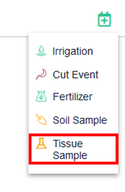
- This will bring up a window with the date of the tissue sample, the Crop Stage (which is optional), and the part of the plant (which is also optional). Select these settings as it applies to your tissue sample.
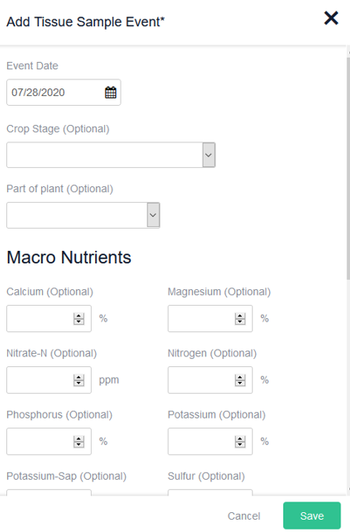
- You can then add results from the lab test including Macro and Micro nutrients.
- Finally, click the “Save” button to save the event.








































